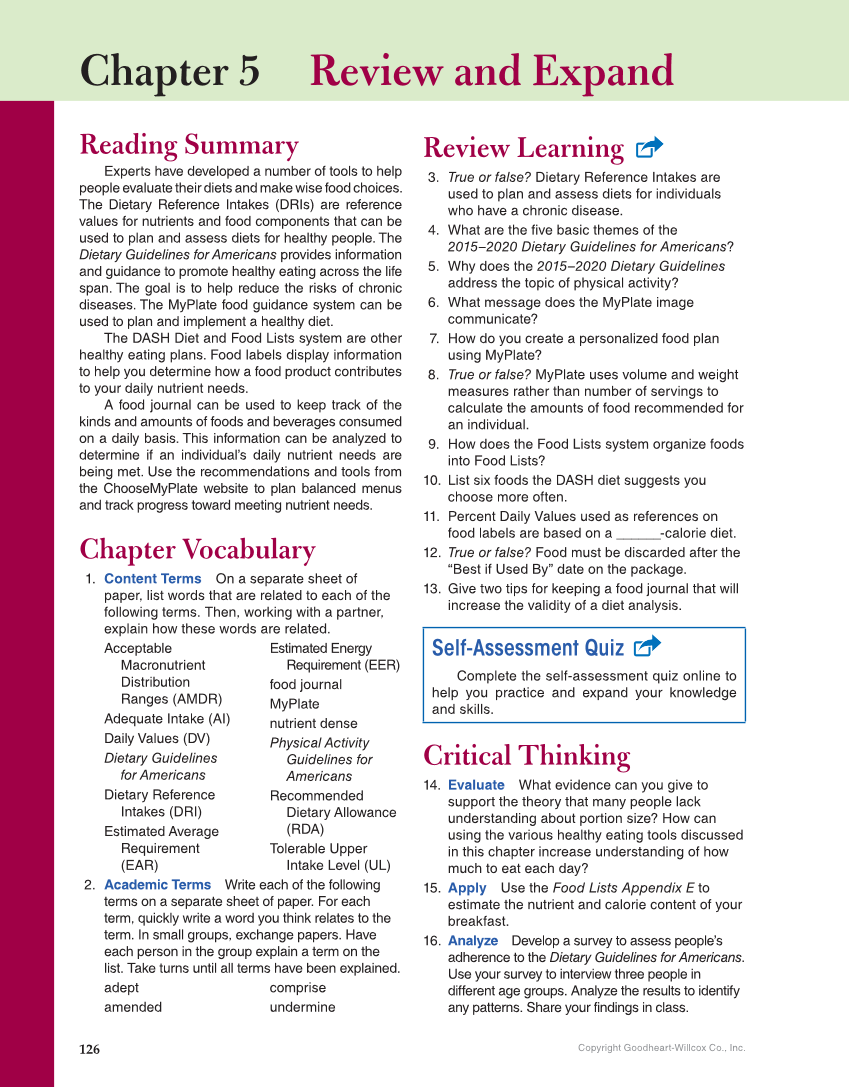Copyright Goodheart-Willcox Co., Inc. Chapter 5 Review and Expand 126 Reading Summary Experts have developed a number of tools to help people evaluate their diets and make wise food choices. The Dietary Reference Intakes (DRIs) are reference values for nutrients and food components that can be used to plan and assess diets for healthy people. The Dietary Guidelines for Americans provides information and guidance to promote healthy eating across the life span. The goal is to help reduce the risks of chronic diseases. The MyPlate food guidance system can be used to plan and implement a healthy diet. The DASH Diet and Food Lists system are other healthy eating plans. Food labels display information to help you determine how a food product contributes to your daily nutrient needs. A food journal can be used to keep track of the kinds and amounts of foods and beverages consumed on a daily basis. This information can be analyzed to determine if an individual’s daily nutrient needs are being met. Use the recommendations and tools from the ChooseMyPlate website to plan balanced menus and track progress toward meeting nutrient needs. Chapter Vocabulary 1. Content Terms On a separate sheet of paper, list words that are related to each of the following terms. Then, working with a partner, explain how these words are related. Acceptable Macronutrient Distribution Ranges (AMDR) Adequate Intake (AI) Daily Values (DV) Dietary Guidelines for Americans Dietary Reference Intakes (DRI) Estimated Average Requirement (EAR) Estimated Energy Requirement (EER) food journal MyPlate nutrient dense Physical Activity Guidelines for Americans Recommended Dietary Allowance (RDA) Tolerable Upper Intake Level (UL) 2. Academic Terms Write each of the following terms on a separate sheet of paper. For each term, quickly write a word you think relates to the term. In small groups, exchange papers. Have each person in the group explain a term on the list. Take turns until all terms have been explained. adept amended comprise undermine Review Learning 3. True or false? Dietary Reference Intakes are used to plan and assess diets for individuals who have a chronic disease. 4. What are the five basic themes of the 2015–2020 Dietary Guidelines for Americans? 5. Why does the 2015–2020 Dietary Guidelines address the topic of physical activity? 6. What message does the MyPlate image communicate? 7. How do you create a personalized food plan using MyPlate? 8. True or false? MyPlate uses volume and weight measures rather than number of servings to calculate the amounts of food recommended for an individual. 9. How does the Food Lists system organize foods into Food Lists? 10. List six foods the DASH diet suggests you choose more often. 11. Percent Daily Values used as references on food labels are based on a ______-calorie diet. 12. True or false? Food must be discarded after the “Best if Used By” date on the package. 13. Give two tips for keeping a food journal that will increase the validity of a diet analysis. Self-Assessment Quiz Complete the self-assessment quiz online to help you practice and expand your knowledge and skills. Critical Thinking 14. Evaluate What evidence can you give to support the theory that many people lack understanding about portion size? How can using the various healthy eating tools discussed in this chapter increase understanding of how much to eat each day? 15. Apply Use the Food Lists Appendix E to estimate the nutrient and calorie content of your breakfast. 16. Analyze Develop a survey to assess people’s adherence to the Dietary Guidelines for Americans. Use your survey to interview three people in different age groups. Analyze the results to identify any patterns. Share your findings in class.
